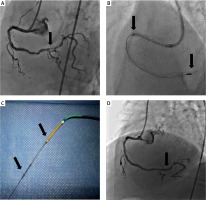Extensive coronary calcification may affect procedural outcomes of coronary angioplasty, resulting in impaired device deliverability, especially in distal locations of the stenosis [1]. In some cases, balloon predilatation is not enough for successful dilatation of the lesion and high speed rotational atherectomy is needed to perform the procedure. Due to the limited length of effective rotablation (advancer moving length – 7 cm), deliverability to the distal plaque location is impossible.
In the present case, we used a 90 cm length 7 Fr guiding catheter with 7 Fr guiding extension (Guideliner, Teleflex Co) to deliver a 1.25 mm Rotablator burr to the postero-lateral branch of the right coronary artery. Because of the risk of burr stack on the first arterial bend, we placed the tip of the Guideliner below this bend and using the standard Dynaglide protocol, the burr was advanced distally. After successful rotablation with the regular protocol, the burr was removed using the Dynaglide protocol. After that, coronary stenting was performed without any obstacles.
The well-known limitation of the high speed rotational atherectomy system is the quite short range of burr movement. Additionally, the artery’s bending provides a risk of burr stack. In the present case, we used the Guideliner to overcome the mentioned issues [2]. Of course, one should remember that the internal diameter of the guiding extension has to be matched with the outer diameter of the burr. Based on our experience, we can recommend checking the matching outside the patient.
A very important issue is the protocol of system manipulation. We advise using Dynaglide protocol to advance and remove the burr with careful manipulation of the burr at the tip of the guiding extension during removal just to prevent damage of the tip. On the other hand, the risk is comparable to the regular situation with the guiding catheter.
We think that the guiding extension for rotablation burr advancement is a valuable option for some distal locations of a calcified lesion treated with coronary angioplasty. Of course, it can also be used for tortuous arteries with high degree bends [3].
Figure 1
A – Coronary angioplasty of the postero-lateral branch of the right coronary artery (arrow). B – Short guiding catheter (Launcher JR 4.0, 90 cm, Medtronic Co) with guide extension (arrow) and parking position of 1.25 mm burr is shown. C – Presentation of used devices – distal tip of Guideliner extension and rotablation burr are marked. D – Final result of coronary stenting









